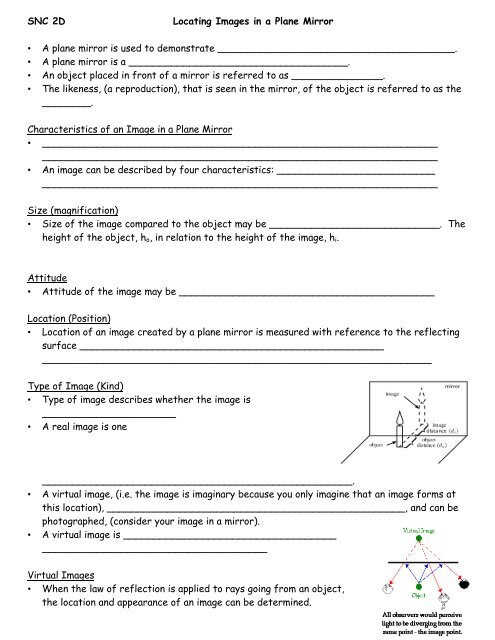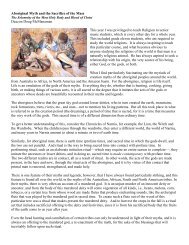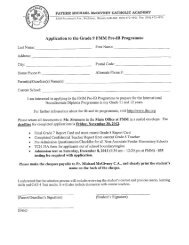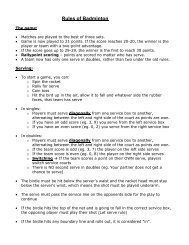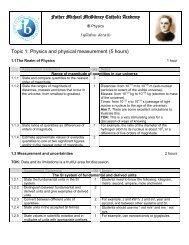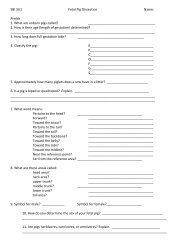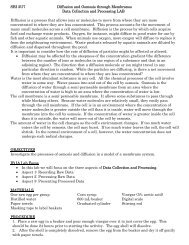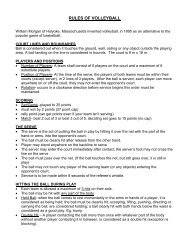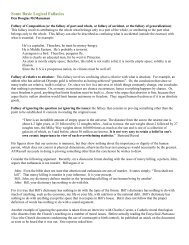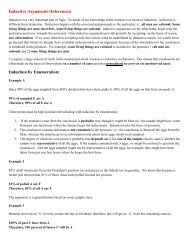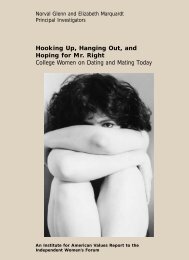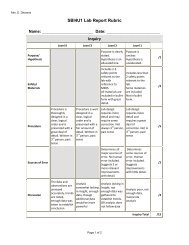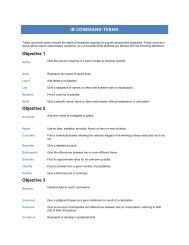Lesson 6: Locating Images in Mirrors
Lesson 6: Locating Images in Mirrors
Lesson 6: Locating Images in Mirrors
You also want an ePaper? Increase the reach of your titles
YUMPU automatically turns print PDFs into web optimized ePapers that Google loves.
SNC 2D<br />
<strong>Locat<strong>in</strong>g</strong> <strong>Images</strong> <strong>in</strong> a Plane Mirror<br />
• A plane mirror is used to demonstrate _______________________________________.<br />
• A plane mirror is a ____________________________________.<br />
• An object placed <strong>in</strong> front of a mirror is referred to as _______________.<br />
• The likeness, (a reproduction), that is seen <strong>in</strong> the mirror, of the object is referred to as the<br />
________.<br />
Characteristics of an Image <strong>in</strong> a Plane Mirror<br />
• _________________________________________________________________<br />
_________________________________________________________________<br />
• An image can be described by four characteristics: __________________________<br />
_________________________________________________________________<br />
Size (magnification)<br />
• Size of the image compared to the object may be ____________________________. The<br />
height of the object, h o , <strong>in</strong> relation to the height of the image, h i .<br />
• (M = h i /h o )<br />
Attitude<br />
• Attitude of the image may be __________________________________________<br />
Location (Position)<br />
• Location of an image created by a plane mirror is measured with reference to the reflect<strong>in</strong>g<br />
surface __________________________________________________<br />
________________________________________________________________<br />
Type of Image (K<strong>in</strong>d)<br />
• Type of image describes whether the image is<br />
______________________<br />
• A real image is one<br />
___________________________________________________.<br />
• A virtual image, (i.e. the image is imag<strong>in</strong>ary because you only imag<strong>in</strong>e that an image forms at<br />
this location), _________________________________________________, and can be<br />
photographed, (consider your image <strong>in</strong> a mirror).<br />
• A virtual image is ___________________________________<br />
_____________________________________<br />
Virtual <strong>Images</strong><br />
• When the law of reflection is applied to rays go<strong>in</strong>g from an object,<br />
the location and appearance of an image can be determ<strong>in</strong>ed.
• The bra<strong>in</strong> assumes that a light ray travels <strong>in</strong> a straight l<strong>in</strong>e. Therefore, to f<strong>in</strong>d out where<br />
the eye “sees” the image, extend the rays that reach the eye backward until they meet at a<br />
po<strong>in</strong>t beh<strong>in</strong>d the mirror.<br />
• This image is called a virtual image.<br />
Us<strong>in</strong>g Light Rays to locate an image <strong>in</strong> a plane mirror<br />
• By apply<strong>in</strong>g the laws of reflection to rays go<strong>in</strong>g from the object, i.e. by draw<strong>in</strong>g a ray diagram,<br />
we can predict where the image will be and what the image will look like, i.e., it is possible to<br />
predict the characteristics oft the image.<br />
How to draw a ray diagram for an object placed <strong>in</strong> a plane mirror:<br />
1. Draw a l<strong>in</strong>e to represent a mirror, add hatch marks to show the non-reflect<strong>in</strong>g surface of the<br />
mirror.<br />
2. Draw the object as a vertical arrow <strong>in</strong> front of the plane mirror.<br />
3. Draw an <strong>in</strong>cident ray from the tip of the arrow at a 90 ◦ angle. Because this l<strong>in</strong>e is normal to<br />
the mirror, the ____________________. Therefore, the ___________________ _____.<br />
The reflected ray goes directly backward along the same l<strong>in</strong>e as the <strong>in</strong>cident ray.<br />
4. Draw a second <strong>in</strong>cident ray at an angle to the mirror. At the po<strong>in</strong>t where the <strong>in</strong>cident ray<br />
hits the mirror, draw a normal. Measure the angle of <strong>in</strong>cidence with a protractor. Us<strong>in</strong>g the<br />
Law of reflection that the angle of reflection is equal to the angle of <strong>in</strong>cidence, draw the<br />
reflected ray.<br />
5. Us<strong>in</strong>g a dashed l<strong>in</strong>e, extend both the reflected rays beh<strong>in</strong>d the mirror until they cross one<br />
another at the same po<strong>in</strong>t, i.e. at the po<strong>in</strong>t where they meet – this po<strong>in</strong>t is the image of the<br />
arrow tip.<br />
* _____________________________________.
Conclusions:<br />
1. ___________________________________________________________<br />
2. _______________________________<br />
3. ___________________________________________________________________<br />
_____________________________________________________<br />
4. ___________________________________________________________________<br />
______________________________________________<br />
To locate any po<strong>in</strong>t on the image, only two <strong>in</strong>cident light rays are necessary.<br />
• Usually, any two of these rays are drawn from the tip of the object; the third ray serves as a<br />
check.<br />
The two light rays are:<br />
1. _____________________________________________________________________<br />
2. _____________________________________________________________________<br />
Lateral Inversion<br />
• Another important characteristic<br />
of images <strong>in</strong> plane mirrors is<br />
observed upon compar<strong>in</strong>g writ<strong>in</strong>g <strong>in</strong><br />
a plane mirror.<br />
• The writ<strong>in</strong>g looks as if it is<br />
backwards, the order of the<br />
letters is reversed, right to left<br />
and left to right.<br />
• In other words, each letter is<br />
flipped horizontally and the letters are <strong>in</strong> reverse order.<br />
• This characteristic of images <strong>in</strong> plane mirrors is called ________ ________<br />
Review<br />
1. There is a special <strong>in</strong>cident ray that reflects right back on itself.<br />
a. How would you aim this <strong>in</strong>cident ray to achieve that effect?<br />
b. What is the angle of <strong>in</strong>cident of this <strong>in</strong>cident ray?<br />
2. a. Name the four characteristics that describe any image.<br />
b. How is a real image different from a virtual image?<br />
3. You stand 1.8 m <strong>in</strong> front of a plane mirror as you are brush<strong>in</strong>g your teeth. Use SALT to<br />
describe the characteristics of the image.<br />
4. You are wear<strong>in</strong>g a T-shirt that has the word OPTICS on it. You stand <strong>in</strong> front of a plane<br />
mirror. Write down how this word appears as you look <strong>in</strong> the mirror.<br />
5. A periscope is a device that is used to see around corners, over a wall, or above water.<br />
Simple periscopes conta<strong>in</strong> two plane mirrors.<br />
a. Predict how these mirrors are arranged.<br />
b. Draw a diagram to illustrate how such a periscope would work.<br />
6. Emergency vehicles make use of lateral <strong>in</strong>version when pa<strong>in</strong>t<strong>in</strong>g words and pictures on the<br />
hoods. Why do you th<strong>in</strong>k this is so?


